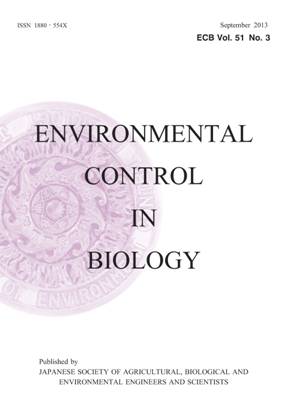All issues

Volume 55 (2017)
- Issue 4 Pages 147-
- Issue 3 Pages 113-
- Issue 2 Pages 59-
- Issue 1 Pages 1-
Predecessor
Volume 55, Issue 4
Environmental Control in Biology
Displaying 1-4 of 4 articles from this issue
- |<
- <
- 1
- >
- >|
Original Paper
-
Takahiro KUMANO, Hajime ARAKI2017Volume 55Issue 4 Pages 147-154
Published: 2017
Released on J-STAGE: October 17, 2017
JOURNAL FREE ACCESSUnder a high-K stressful condition in a greenhouse pot cultivation, the biomass production and the K absorption capacity of witloof chicory (Cichorium intybus L.) were compared with forage chicory. The root biomass of witloof chicory was greater than that of forage chicory among all treatments, indicating that witloof chicory has a certain level of tolerance against high K stressful conditions. As K2O application increased, the biomass, in top and root, tended to decrease in both types, however, there was not a significant negative impact on the yield or quality of the obtained roots in witloof type at the treatments under 2,000 kg ha−1 level. The K-uptake amount per plant of witloof chicory was 40% to 58% greater comparing forage chicory, at the K2O treatments from 1,000 to 2,000 kg ha−1. The quality of the etiolated heads, obtained after the forcing culture, could be kept at the same level of the commercially available fresh products when the K2O application was lower than 2,000 kg ha−1. Through this experiment, witloof chicory showed its potential to be utilized as a remedy for K accumulated soils, concurrently, obtaining an agricultural income from the forcing culture by using roots which absorbed K from soils.View full abstractDownload PDF (233K) -
Takahiro KUMANO, Hajime ARAKI2017Volume 55Issue 4 Pages 155-164
Published: 2017
Released on J-STAGE: October 17, 2017
JOURNAL FREE ACCESSTo evaluate the potential of witloof chicory (Cichorium intybus L.) (VI) as a remedy for K accumulated soils, the K absorption ability of VI under nutrient-rich condition were analysed together with forage type chicory and guinea grass (Punicum maximum Jacq.) (GG) by using modelled salt accumulated soils made by excessive application (733 t ha−1 in 2 years total) of Methane Fermentation Digested Slurry (DS) of cow manure for 2 years. Comparing to the first year, the top biomass of VI in the second year was maintained at the same level and that of root were significantly increased (P<0.05) while the plant total biomass of GG was significantly decreased (P<0.05), and no significant differences were observed in plant total biomass of forage type chicory. The K-uptake amount per plant of VI was 37.6% larger than that of GG, and 73.8% larger than that of forage chicory at 5% level of significance. Through forcing culture experiment, influence of excessive DS application for two years was negligible on production of etiolated heads. In conclusion, the witloof chicory can be utilized for K removal from salt accumulated soils concurrently with deriving income through etiolated head production.View full abstractDownload PDF (673K) -
Yuta MIYOSHI, Kota HIDAKA, Takashi OKAYASU, Daisuke YASUTAKE, Masaharu ...2017Volume 55Issue 4 Pages 165-170
Published: 2017
Released on J-STAGE: October 17, 2017
JOURNAL FREE ACCESSIn strawberry production, carbon dioxide (CO2) enrichment is widely used to promote crop photosynthesis and to improve growth and yield of strawberry fruits. However, a standard CO2 enrichment method has not been established clearly. For sustainable strawberry production with high profitability, it is essential to establish an efficient system for CO2 enrichment. Therefore, in this study, we newly propose a local CO2 enrichment system. The system enriches CO2 only ambient to strawberry crops, not a whole greenhouse, and thereby enables efficient control of CO2 concentration. We applied this system in a strawberry cultivation greenhouse with ventilating windows and examined the performance of system. During the daytime on clear days with opened greenhouse ventilation windows, the proposed system stabilized the ambient CO2 concentration to strawberry crops at 800 ppm. Furthermore, when the day after CO2 enrichment was begun, strawberry crop photosynthesis and photosynthate translocation from source leaves were promoted as the effects of short-term CO2 enrichment. Nevertheless, the yields and quality of fruits was not affected by the system. It is considered that long-term CO2 enrichment thickened source leaves and thereby caused down-regulation of photosynthesis. Further consideration will be needed on effect of long-term CO2 enrichment on physiological function of crops.View full abstractDownload PDF (276K)
Short Communication
-
Takanori HORIBE2017Volume 55Issue 4 Pages 171-174
Published: 2017
Released on J-STAGE: October 17, 2017
JOURNAL FREE ACCESSThere are many advantages associated with the hydroponic culture of edible Opuntia, including the precise fertilizer management and elimination of soil-borne diseases and weeds. We designed a new cost-effective and simple method for the hydroponic culture of edible Opuntia, and assessed its effectiveness by comparing the growth of cladodes by this method and by pot culture using a growth chamber and a greenhouse. The average length of the first daughter cladodes grown in the hydroponics culture was greater than that in the pot culture in both the growth chamber and the greenhouse. The total fresh weight (FW) of cladodes harvested from one mother in the hydroponics culture with fertilizer was greater than that in the pot culture and became significantly larger in the greenhouse as compared with that in the growth chamber in all the treatments. The speed of cladode growth and FW of harvested cladodes were least in cladodes grown in the hydroponics culture without any fertilizer. These results showed that growth conditions, including fertilizer concentration, temperature, and light environment greatly affect cladode growth. Our results suggest that the new proposed hydroponic culture method is effective for the cultivation of edible Opuntia.View full abstractDownload PDF (578K)
- |<
- <
- 1
- >
- >|